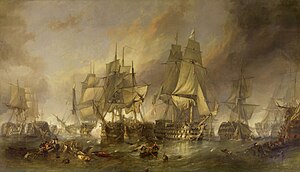| Battle of Trafalgar | |||||||
|---|---|---|---|---|---|---|---|
| Part of the Trafalgar campaign of the War of the Third Coalition | |||||||
 The Battle of Trafalgar, 21 October 1805 by Clarkson Frederick Stanfield | |||||||
| |||||||
| Belligerents | |||||||
|
| |||||||
| Commanders and leaders | |||||||
| Strength | |||||||
|
27 ships of the line 4 frigates 1 schooner 1 cutter 2,148 guns 17,000 men[2] |
33 ships of the line 5 frigates 2 brigs 2,632 guns 30,000 men[2] | ||||||
| Casualties and losses | |||||||
|
458 killed 1,208 wounded[3] |
4,395 killed 2,541 wounded 7,000–8,000 captured 17 ships of the line captured 1 ship of the line destroyed[4] | ||||||
Location within Europe | |||||||
The Battle of Trafalgar was a naval engagement that took place on 21 October 1805 between the British Royal Navy and the combined fleets of the French and Spanish Navies during the War of the Third Coalition (August–December 1805) of the Napoleonic Wars (1803–1815).[5]
As part of Napoleon's plans to invade the United Kingdom, the French and Spanish fleets combined to take control of the English Channel and provide the Grande Armée safe passage. The allied fleet, under the command of the French admiral, Pierre-Charles Villeneuve, sailed from the port of Cádiz in the south of Spain on 18 October 1805. They encountered the British fleet under Lord Nelson, recently assembled to meet this threat, in the Atlantic Ocean along the southwest coast of Spain, off Cape Trafalgar.
Nelson was outnumbered, with 27 British ships of the line to 33 allied ships including the largest warship in either fleet, the Spanish Santísima Trinidad. To address this imbalance, Nelson sailed his fleet directly at the allied battle line's flank, hoping to break the line into pieces. Villeneuve had worried that Nelson might attempt this tactic, but for various reasons, failed to prepare for it. The plan worked almost perfectly; Nelson's columns split the Franco-Spanish fleet in three, isolating the rear half from Villeneuve's flag aboard Bucentaure. The allied vanguard sailed off while it attempted to turn around, giving the British temporary superiority over the remainder of their fleet. In the ensuing fierce battle 20 allied ships were lost, while the British lost none.
The offensive exposed the leading British ships to intense crossfire as they approached the Franco-Spanish lines. Nelson's own HMS Victory led the front column and was almost knocked out of action. Nelson was shot by a French musketeer during the battle, and died shortly before it ended. Villeneuve was captured along with his flagship Bucentaure. He attended Nelson's funeral while a captive on parole in Britain. The senior Spanish fleet officer, Admiral Federico Gravina, escaped with the surviving third of the Franco-Spanish fleet; he died five months later of wounds sustained during the battle.
The victory confirmed British naval supremacy, and was achieved in part through Nelson's departure from prevailing naval tactical orthodoxy.[6]
- ^ Harrison, Cy, ed. (26 April 2020). "Battle of Trafalgar, 21st October 1805". Three Decks. Three Decks, Cy Harrison. Archived from the original on 3 June 2021. Retrieved 19 July 2021.
- ^ a b Goodwin 2002, p. 257.
- ^ Adkin (2005), p. 524.
- ^ Adkins (2004), p. 190.
- ^ "Napoleonic Wars". Westpoint.edu. U.S. Army. Archived from the original on 28 July 2014. Retrieved 1 July 2017.
- ^ Bennet, Geoffrey (2004). The Battle of Trafalgar. England: Pen & Sword Books Limited, CPI UK, South Yorkshire.
